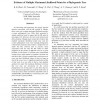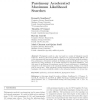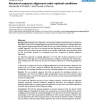29 search results - page 2 / 6 » Finding a maximum likelihood tree is hard |
BIBE
2006
IEEE
13 years 10 months ago
2006
IEEE
An interesting and important, but largely ignored question associated with the ML method is whether there exists only a single maximum likelihood point for a given phylogenetic tr...
PODS
2007
ACM
14 years 4 months ago
2007
ACM
We consider the problem of constructing decision trees for entity identification from a given relational table. The input is a table containing information about a set of entities...
BMCBI
2008
13 years 4 months ago
2008
Background: Inference of evolutionary trees using the maximum likelihood principle is NP-hard. Therefore, all practical methods rely on heuristics. The topological transformations...
IJCBDD
2008
13 years 4 months ago
2008
: Phylogenetic search is a key tool used in a variety of biological research endeavors. However, this search problem is known to be computationally difficult, due to the astronomic...
BMCBI
2005
13 years 4 months ago
2005
Background: Multiple genome alignment is an important problem in bioinformatics. An important subproblem used by many multiple alignment approaches is that of aligning two multipl...



